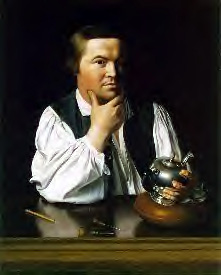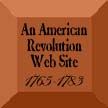

 Paul Revere Paul Revere
 An American patriot and silversmith, Paul Revere
was born in Boston, Jan. 1, 1735, and died May 10, 1818. Revere
became a legendary hero at the start of the American Revolution,
when he rode from Charlestown to Lexington,
Mass., on the night of Apr. 18, 1775, to warn the countryside
of approaching British troops.
An American patriot and silversmith, Paul Revere
was born in Boston, Jan. 1, 1735, and died May 10, 1818. Revere
became a legendary hero at the start of the American Revolution,
when he rode from Charlestown to Lexington,
Mass., on the night of Apr. 18, 1775, to warn the countryside
of approaching British troops. |
|
|
An official courier for the Massachusetts Committee
of Correspondence, Revere arrived in Lexington shortly before
another rider, William Dawes, and warned John
Hancock and Samuel Adams to escape.
Revere then started for Concord accompanied by Dawes and Samuel
Prescott but was halted by a British patrol. Only Prescott
reached Concord. Revere's exploit was celebrated in Henry
Wadsworth Longfellow's famous (but generally inaccurate) poem,
"Paul Revere's Ride" (1863).
In the above portrait, Paul Revere holds an unfinished
silver teapot painted by John Singleton
Copley around 1765. The energetic, colorful Revere
organized a network of more than 60 fellow artisans that formed
the secret heart of Boston's Revolutionary movement.
His father, Apollos Rivoire (or De Rivoire), was a
Huguenot who had gone to Boston while still a boy as a refugee
from religious persecution in France. Apprenticed to the silversmith
John Coney, Apollos had married Deborah Hitchbourn (Hitchborn),
and he gradually Anglicized his name as Paul Revere. As an independent
silversmith, the elder Revere had become a man of substance by
the time his son Paul was born, in Boston, Mass., on Jan. 1,
1735.
Young Paul learned the trade of silversmith in his
father's shop, and probably attended the North Writing (or Grammar)
School while serving his apprenticeship. In 1756 he enlisted
for the unsuccessful expedition against the French post at Crown
Point, serving as second lieutenant. A few months after his return,
in the summer of 1757, he married Sarah (“Sary”) Orne,
by whom he was to have eight children.
Revere is remembered as much as a craftsman as he
is as a patriot. His anti-British engravings of episodes such
as the Boston Massacre were effective
propaganda. He cast musket balls and cannon during the war and
designed and printed the first Continental currency. After the
war he became one of New England's leading silversmiths and a
pioneer in the production of copper plating in America. |
~ Anti-British Activist
~
When tension developed between the colonies and the mother country
after the end of the Seven Years' War (1756–1763), Paul
Revere emerged as one of the leaders of the group of artisans
who identified themselves with the critics of the policies of
the mother country. As a Mason he had already come to be associated
with James Otis, Joseph Warren, and other libertarians. He now
became a member of various Whig groups, organized and unorganized,
such as the Sons of Liberty, the North
End Caucus, and the Long Room Club. He was probably a witness
of, although not certainly a participant in, the Stamp
Act riots and the looting of Gov. Thomas
Hutchinson's house.
Meanwhile, although his fame as a silversmith steadily
mounted, business fell off for several years, and Revere turned
to other trades to supplement his income. He did copper engraving,
although his skill as a draftsman was woefully inadequate, drew
political cartoons for the Whig polemicists, published music,
and even went in for dentistry, a craft that he soon dropped.
He was not only one of the most versatile and outstanding artisans
of Boston; he was also an active political leader.
He observed the coming of the customs commissioners
and the British troops to Boston in
1768, and published a series of engravings that commemorated
the latter event. When the so-called Boston
Massacre took place in 1770, he published a famous drawing
of the scene that doubtless aroused as much resentment against
the British troops as the event itself.
In the years between 1770 and 1773, Revere became
an express (mounted messenger) for the Whig patriots of Boston.
At the time of the arrival of the tea ships in the autumn of
1773, he rode out to warn the committees of correspondence of
the other ports along the coast not to permit the ships to land
their cargoes. A little later, after he himself had been one
of the “Indians” in the Boston
Tea Party, he rode to Pennsylvania for the Boston committee
to carry the news of the party to the committees of New York
and Philadelphia. |
 ~ Wartime Services ~ ~ Wartime Services ~
|
It was in the spring of 1775 that Revere made
the famous ride described by Henry Wadsworth Longfellow that
placed him among the immortals of the American national tradition.
Gen. Thomas Gage, the British military
governor of Massachusetts, had decided to arrest John
Hancock and Samuel Adams, who were
at Lexington, and to confiscate the
military supplies stored by the Whigs at Concord. |
|
|
On Sunday, April 16, four days before the projected
Gage expedition, Revere rode out to Lexington to warn Hancock
and Adams, and sent word to the Whigs at Concord to hide the
stores. At this time he arranged to signal the patriots by showing
two lanterns in Boston's North Church steeple if the British
moved by sea or one if by land. |

|
On the night of Tuesday, April 18, Revere and
William Dawes rode out, Dawes by way of Boston Neck and Revere
by way of Charlestown, to alert the countryside that the British
troops would move the next morning. Revere arrived in Lexington
about half an hour before Dawes, and Hancock and Adams fled to
Woburn. Revere, Dawes, and Dr. Samuel Prescott started for Concord,
but Dawes and Revere were stopped by a British patrol; Prescott
got through. Revere was released by the British and returned
to Lexington to help in saving John Hancock's trunk and papers. |
|
|
During the first years of the war, Revere served as
a messenger for the Committee of Safety, with headquarters at
Cambridge. He was then commissioned by the Provincial Congress
to manufacture gunpowder. He also designed and printed the first
issue of Continental money, and made the first official seal
for the colonies and the state seal for Massachusetts. After
the reoccupation of Boston in 1776, he again took up his old
trade. He reached the rank of lieutenant colonel and was placed
in command of Castle William (Castle Island) in Boston Harbor.
Meanwhile he had begun to cast cannon for the American Army. |
|
~ Postwar Years ~
“Sary” Revere died on May 3, 1773, and Revere
married Rachel Walker on October 10. They had eight children.
After the war he went into merchandising and, later, bell casting,
but silversmithing, with the assistance of his son, continued
to be his most dependable and rewarding business. Presently,
at the age of 65, he learned how to roll sheet copper and furnished
the new sheeting for the dome of the Massachusetts State House
and other public buildings, as well as for the hulls of ships
in the young American Navy, including the
Constitution, for which he had earlier furnished bolts, spikes,
braces, and other fittings.
Paul Revere's outstanding characteristic was the versatility
of his craftsmanship; his reputation as an artist in the working
of silver is hardly less great or enduring than his fame as a
patriot. For him, that famous ride to Lexington was hardly more
than an exciting incident that was, in fact, shared by William
Dawes. Because of its dramatic nature, however, it is for the
ride that he is most popularly remembered by succeeding generations. |
(See Bibliography Below)
| Back to Timeline
| or click on your browser's "back to previous page"
button

 ©
©
Authors: George Athan Billias; Max Savelle (contributing).
Picture Credit: Paul Revere (top) by John Singleton
Copley, Museum of Fine Arts, Boston.
Bibliography: American Antiquarian Society, Paul
Revere's Engravings, by Clarence S. Brigham, rev. ed. (1969);
Bigelow, Francis H., Historic Silver of the Colonies and Its
Makers, rev. ed. (1925); Brigham, Clarence, Paul Revere's
Engraving (rev. ed. 1969); Buhler, Kathryn C., Paul Revere,
Goldsmith: 1735–1818 (Boston 1975); Forbes, Esther, Paul
Revere and the World He Lived In (1942; repr. 1962); Goss,
Elbridge, The Life of Colonel Paul Revere (1891; repr.
1972); Grant, Matthew G., Paul Revere (1974); Paul Revere
Memorial Association, Paul Revere, Artisan, Businessman, and Patriot
(1988); Stevenson, Augusta, Paul Revere: Boston Patriot
(1984).
© Copyright "The American Revoulution Home Page" - Ronald
W. McGranahan 1998 - 2004. All Rights Reserved.

